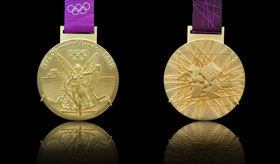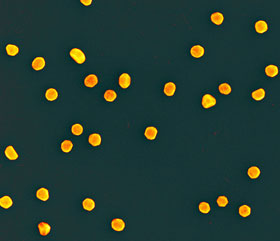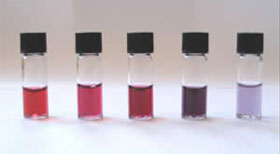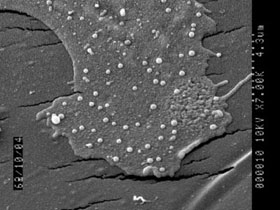The Golden Age of Gold

The front and back of 2012 London Olympics gold medal.

False color scanning electron micrograph (250,000 times magnification) showing gold nanoparticles created by NIST and the National Cancer Institute's Nanotechnology Characterization Laboratory for use as reference standards in biomedical research laboratories. Credit: Andras Vladar, NIST.

Solutions containing gold nanoparticles of different types and sizes. The particles get larger from left to right. Credit: Aleksandar Kondinski, Creative Commons Attribution-Share Alike

Gold nanoparticles, the bright structures attached to the cultured human cell in this electron microscope image, may help improve the diagnosis and treatment of cancer. Credit: Catherine C. Berry; National Science Foundation
During the Olympic Games, gold takes center stage. The precious metal adorns the necks of the fastest, strongest, and most talented athletes in the world. Gold medals have been used to honor Olympic champions for more than 100 years, and were chosen for this occasion because they symbolize the Golden Age of Mankind in Greek mythology, a time when men lived like gods among the gods. According to Greek mythology the Golden Age ended long ago for mankind, but new research on gold indicates that we may now be in the golden age of gold.
Scientists have found that tiny particles of gold no more than one hundred nanometers in diameter (a nanometer is one billionth of a meter, or 10-9 meters) that are suspended in a liquid have properties that make them extremely useful for a wide variety of applications. In the last few years researchers have published journal articles citing the promise of these particles, called gold nanoparticles, in treating prostate cancer, tagging brain tumors before surgery, catalyzing fuel-cell reactions, diagnosing lung cancer, boosting the efficiency of solar cells, diagnosing influenza, removing containments from groundwater, reducing the pain caused by rheumatoid arthritis, detecting Salmonella in lettuce, and treating Alzheimer's disease; just to name a few.
One of the most intriguing features of gold nanoparticles are the vibrant colors they produce. When small gold nanoparticles are suspended in a solution, the solution appears as a deep red color. As the particles increase in size, the solutions turn pale blue or purple and eventually become colorless. The color can also be changed by changing the shape of the nanoparticles, the concentration of nanoparticles in a solution, or by changing the properties of the solution.
The vibrant colors are the result of how nanoparticles interact with light. When light shines on gold nanoparticles, the nanoparticles are very efficient at absorbing specific frequencies and intensely scattering other frequencies. The specific frequencies that are absorbed and scattered depend on the size, shape, and environment of the nanoparticles. For example, individual gold nanoparticles appear red because they scatter red light most intensely, but when many of them are clumped together, the aggregate scatters blue light most intensely.
This makes gold nanoparticles very useful for applications like detecting the bacteria Salmonella in lettuce. Recently, a research group led by Paresh C. Ray from Jackson State University attached Salmonella antibodies to gold nanoparticles, and then added a few drops of the solution to some lettuce. When the antibodies encountered a Salmonella microbe, they latched on. Because the gold nanoparticles are so small, many of them latched on to each Salmonella microbe. A simple test of the lettuce looked for the blue light produced by an aggregate of gold nanoparticles, which indicated the presence of Salmonella. The researchers are now working on making this test commercially available because it is much faster than current methods. Initial results show that this process could also lead to an effective way to get rid of the bacteria--if the nanoparticles are illuminated with laser light, they heat up and destroy the Salmonella.
Gold nanoparticles are used to detect cancer cells in similar ways. Scientists prepare the nanoparticles by attaching them to specific antibodies that bind to cancerous cells, or by adding coatings that make them attractive to cancerous cells, and then inject them into the body. Then, they use different imaging techniques to see what happens to the nanoparticles--for example, if the particles all collect in one area it might indicate the presence of a tumor. Researchers are also exploring the process of illuminating nanoparticles with laser light and destroying cancer cells.
Another way that gold nanoparticles might be used to treat cancer and other health problems is through targeted drug delivery systems. Gold nanoparticles have a large surface area to volume ratio, which means that researchers can coat them with hundreds of molecules. For example, researchers can add antibodies that bind to a cancerous cell along with a drug that will treat the cancer. A team from the University of Missouri led by Kattesh Katti recently attached precisely-sized radioactive gold nanoparticles to a specific compound that is attracted to prostate tumor cells. They injected the particles in mice with prostate cancer, and found that the compound brought the nanoparticles to the tumor and kept them there, enabling the radioactivity from the gold nanoparticles to treat the tumor effectively without destroying healthy cells in other parts of the body. This treatment has fewer side effects than chemotherapy, and only requires a low dose of radioactivity. The team is now exploring how well this technique will work in animals that are more similar to humans.
Gold nanoparticles are also exciting tools for researchers looking to make smaller or more flexible electronic devices. For example, gold nanoparticles can be suspended in a special kind of ink, which can be used to print electronic circuits onto flexible plastic or paper. Gold and silver nanoparticles are ideal for this because they conduct electricity well and don't oxidize, although they are still too expensive for some high-volume, low-cost applications. Researchers are also exploring the use of gold nanoparticles to store electric change in flash memory devices, like the kind used in cell phones and digital cameras, because they enable you to pack information more densely.
The Olympic committee had no knowledge of the varied and exciting applications of gold nanoparticles when they first started bestowing gold medals on athletes. But as the potential of this element to save lives and revolutionize technology emerges, perhaps the world's best athletes would be honored even more if their accomplishments were represented by a vial of gold nanoparticles instead.
For more information, check out these resources:
American Chemical Society: Popcorn-shaped gold particles gang up on Salmonella
Find out more details about the work being done at Jackson State University in this news story.
ScienceDaily: Gold nanoparticles could treat prostate cancer with fewer side effects than chemotherapy
Find out more details about the work being done by the team at the University of Missouri. Also check out the video about this research on YouTube, http://www.youtube.com/watch?v=ktm17Tg1UPg.
Discovery Health: How could gold save my life?
Read more about the role that gold nanoparticles play in detecting cancer.
Introduction to Nanotechnology: Gold nanoparticles 101
Learn about some other applications of gold nanoparticles in this blog post.














